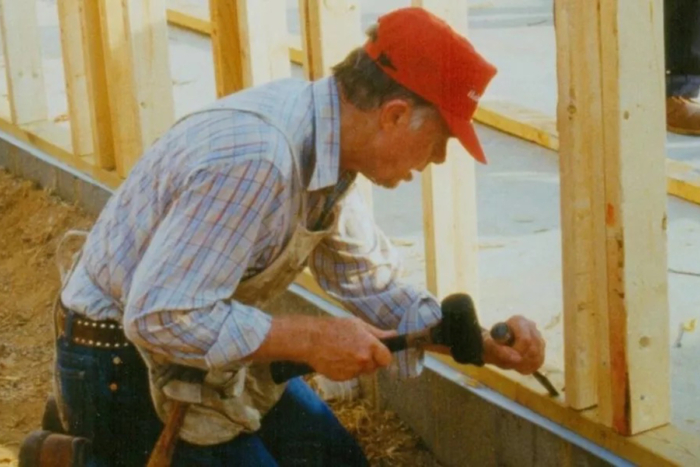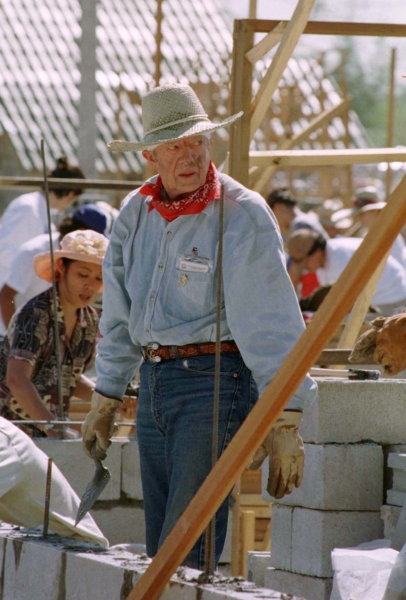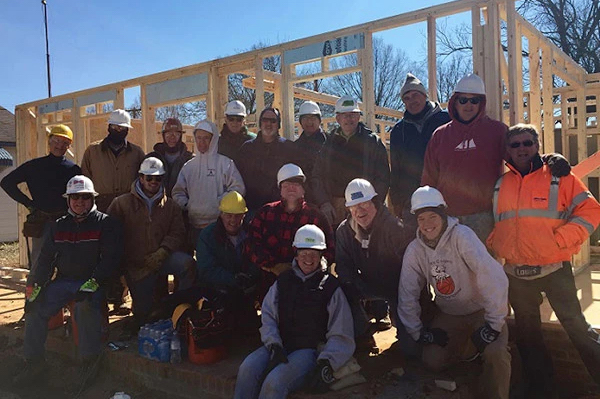Church leaders recall welcoming Jimmy Carter to North Carolina for one of his first Habitat projectsPosted Mar 9, 2023 |
|

Former President Jimmy Carter lends a hand during Habitat for Humanities’ Carter Work Project in 1987 in Charlotte, North Carolina. Photo: Habitat for Humanity of the Charlotte Region
[Episcopal News Service] When former President Jimmy Carter came to Charlotte, North Carolina, for a Habitat for Humanity build in 1987, the Rt. Rev. Henry Parsley recalls being amazed as much by Carter’s skill with a pocketknife as with his joy at hammering nails.
“He believed in what he was doing with Habitat,” Parsley said in a phone interview with Episcopal News Service. “He also could carve a peach with his pocketknife faster than any human being I’ve ever seen.”
Parsley was a priest and rector of Christ Episcopal Church at the time of Carter’s visit to Charlotte. The Rt. Rev. Gary Gloster was serving as the church’s associate rector. Gloster observed that Carter’s Secret Service detail was overly cautious and alert – and jumping at the sound of the construction crews’ nail guns.
“Their job is to protect the president. When guns start going off that they don’t know about, they start getting worried,” Gloster, who later served as the Diocese of North Carolina’s bishop suffragan from 1996 to 2007, told ENS.
Christ Church and other churches in Charlotte hosted Carter that week on what was one of the former president’s first annual Habitat for Humanity trips. He and other volunteers spent less than a week building 14 homes from the ground up for low-income residents, a tradition that continues nationwide to this day as the Carter Work Project.
With Carter, 98, announcing last month his decision to spend his final days in hospice care at his home in Georgia, Parsley and Gloster said they still look back fondly at the experience of working alongside Carter and his wife, Rosalynn Carter. What they remember most was the positive impact that Habitat for Humanity had on the Charlotte community and how graciously Carter lent his name and his energy to the cause.
“Habitat provides a simple but powerful avenue for people of different backgrounds to come together to achieve those most meaningful things in life,” Carter once said, as quoted on Habitat for Humanity’s website. “A decent home, yes, but also a genuine bond with our fellow human beings. A bond that comes with the building up of walls and the breaking down of barriers.”

Former President Jimmy Carter has traveled around the world to promote and help with Habitat for Humanity home-building projects. Here he is on a work site in Manilla, Philippines, in 1999. Photo: Reuters
The Carters got involved with Habitat for Humanity after the president left office in 1981. Today, Carter’s name has long been closely associated with the global nonprofit housing organization, though in 1987, the idea of the Carter Work Project was still relatively new when Charlotte was chosen as just its third city.
A worksite was identified in Charlotte’s Optimist Park neighborhood, where most of the existing housing was in poor condition, according to the University of North Carolina-Charlotte’s online history of the neighborhood. “Charlotteans overwhelmed the Habitat office with offers to help with the project, and more than 350 volunteers aided the building of houses in Optimist Park each day for a week,” the website says.
One of those volunteers was Harold Miller, who was helping to build his own future home on the Carter Work Project site. Looking back, Miller told WFAE-FM in a recent report that Habitat for Humanity offered him and other Charlotte residents an unexpected but welcome path to homeownership. The houses were priced modestly, and buyers were offered mortgages with low monthly payments.
“I think it was nice. You know, because some people would not have been able to get them if they didn’t go through that program,” Miller told WFAE. “They had to put in 300 hours, but it was worth it.”
Parsley spent 10 years at Christ Episcopal Church, until he was elected bishop of Alabama in1996. He retired in 2012. “We built a Habitat house every year,” Parsley recalled of his time in Charlotte. Christ Church had joined with six other churches in 1983 to found what now is known as Habitat for Humanity of the Charlotte Region.
Christ Church has since provided volunteers and other support for regional organization’s success in serving more than 3,500 families over four decades. The congregation remains active in supporting those efforts: Its latest building project began last month and is scheduled to be finished by June, providing a two-story home for Shontel Alexander and her family.
“It’s so much a part of the fabric of the outreach and ministry at Christ Church,” Laura Konitzer, the church’s current director of outreach and mission, told ENS. The congregation budgets about $450,000 for outreach each year, and the $75,000 for Habitat for Humanity is the largest single expense.
“We fully fund [one house] and then our volunteers build alongside the Habitat family every year,” Konitzer said.

Christ Church volunteers pose in 2022 for a photo at their Habitat for Humanity work site in Charlotte, North Carolina. Photo: Christ Church
In addition to those locally driven projects, Habitat for Humanities continues to organize a large-scale Carter Work Project in a different city each year, and Charlotte was again chosen for 2023. This October, Christ Church volunteers will be among those helping to build 20 homes in the Meadows at Plato Price development, as Habitat for Humanity of the Charlotte Region celebrates its 40th anniversary.
Parsley described for ENS the scene during the 1987 project in Charlotte. The volunteers gathered at the home construction sites at 6 a.m. and joined in prayer and hymn singing. Then at 6:30, everyone got to work. “Suddenly the sound of hammers began,” Parsley said. “I’ll never forget it. It was a holy time.”
Carter wasn’t just a spokesman for Habitat. He got involved in these projects in meaningful and personal ways, Parsley said. “The president worked on houses every day, had lunch with us under a tent, and the Carters both had dinner with us, every night at a different church.” Christ Church hosted one of those dinners, serving fried chicken, and “we just had a high old time.”
He added that the former president was down-to-earth and generous and took time to meet with some of the people who would be moving into the houses when they were finished.
“He’s a man of obviously great faith, but one of ecumenical breadth. He just was right at home with all these [faith] traditions together building those houses,” Parsley said. “It was a wonderful week, one of the greatest weeks of my ministry, and what a privilege to be with him.”
– David Paulsen is a senior reporter and editor for Episcopal News Service. He can be reached at dpaulsen@episcopalchurch.org.

Social Menu